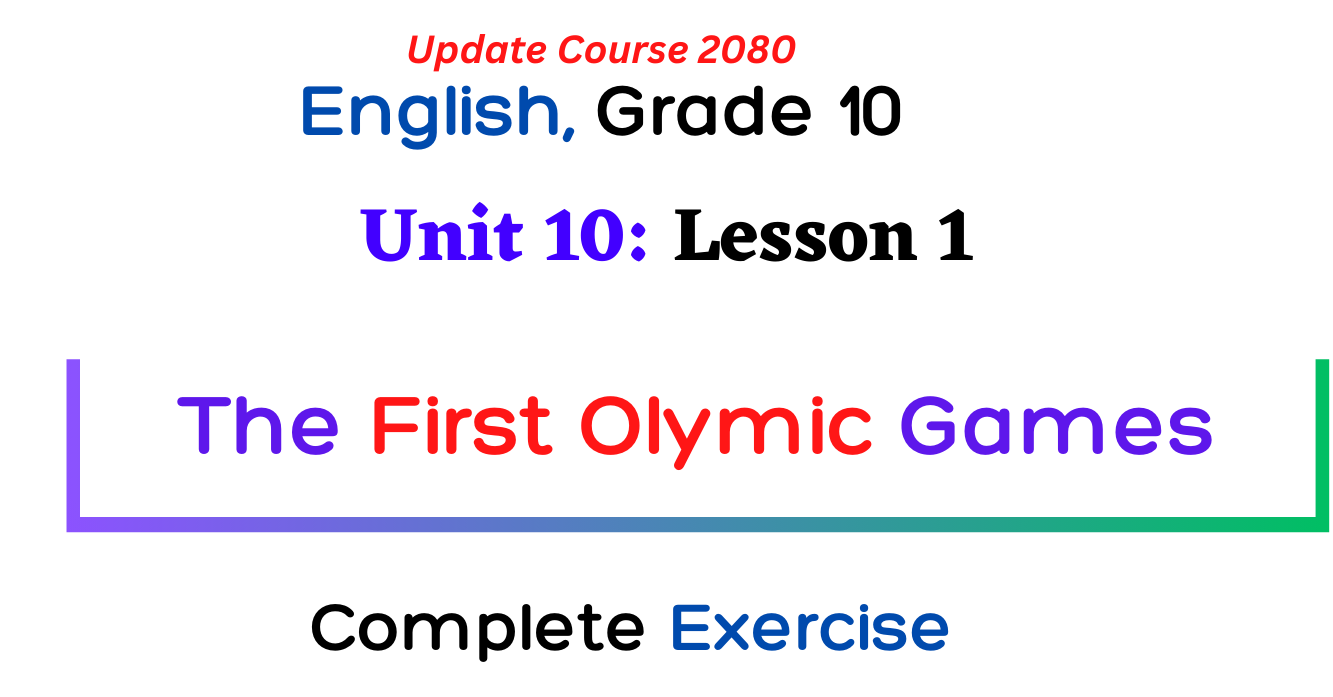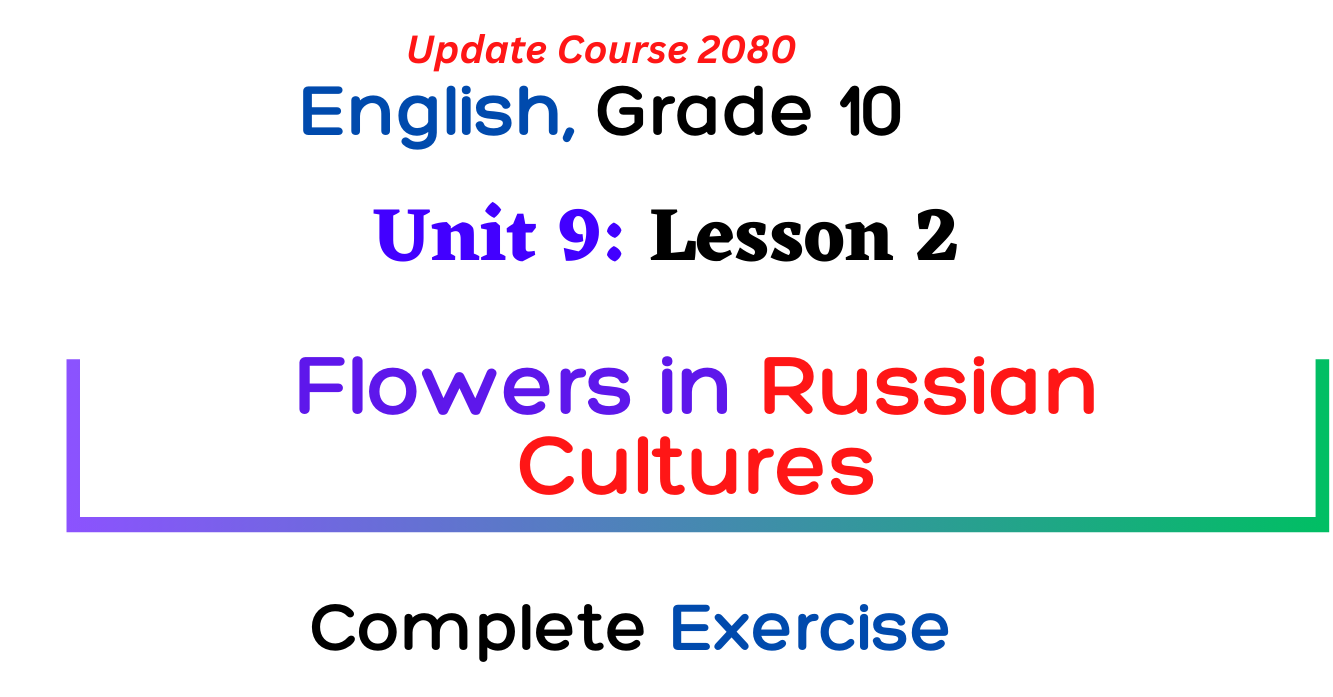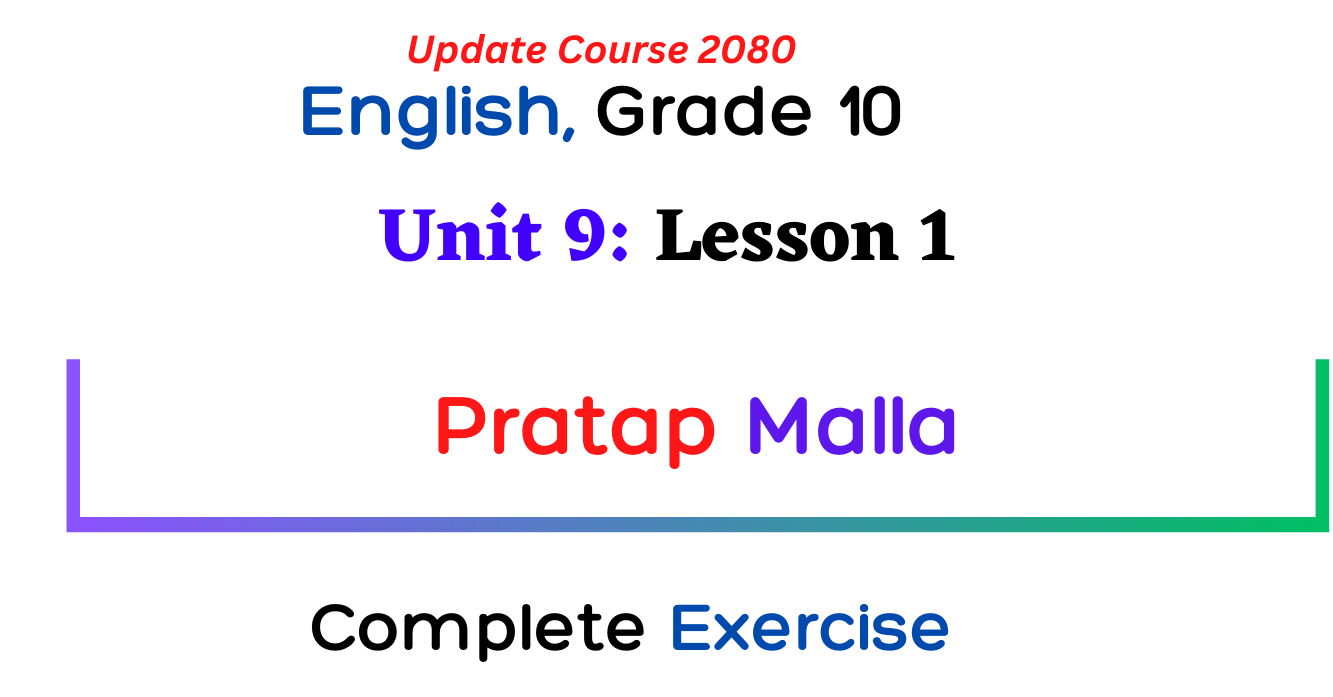Leave This Chanting and Singing
Class 10 English Guide 2080 Chapter 4 Leave This Chanting and Singing Exercise, Summary, Question Answer, Grammar Writing Solution note.
Check: SEE Class 10 Model Question 2080/2081
Reading II
a. What are the people in
pictures doing?
Ans:-
There are two pictures, in the first picture, a farmer is ploughing the field.
He is doing hard work.
In
the second picture, a girl is praying to the god.
b. Why are they doing
these activities?
The
man is doing his daily activity for his survival where as the girl is trying to
please the god through religious practices to get rid of pain and misery.
c. Who, do you think, is
better at serving the god? Why?
I
think the man is better serving the god, because god loves those who are
laborious and enjoys the life on their toil.
Leave this Chanting and Singing Summary
The
poem is written by the Indian poet Rabindranath Tagore and is titled
“Leave This Chanting.” The poem is a call to action and encourages
the reader to leave behind the rituals and traditional practices of worship and
instead seek out the divine through everyday experiences and actions.
Leave this Chanting and Singing
Leave
this chanting and singing and telling of beads!Whom
dost thou worship in this lonely dark corner of a temple with doors all shut?Open
thine eyes and see thy God is not before thee!
The speaker is challenging the traditional practices of religious
worship that are confined to a temple or a specific place. The speaker urges
the reader to stop chanting and singing prayers and counting prayer beads,
which are all ritualistic practices associated with worship in a temple. The
speaker questions the value of such practices and asks the reader to reflect on
whom they are worshipping in a dark, lonely corner of a temple with closed
doors. The speaker suggests that instead of blindly following traditional
practices of worship, the reader should open their eyes and realize that God is
not limited to the confines of a temple. The divine is present everywhere, and
by limiting oneself to a specific place and set of rituals, one may miss out on
the opportunity to experience the divine in everyday life. The speaker
encourages the reader to seek a more personal, experiential relationship with
the divine, which is not confined to any particular place or ritualistic
practice.
He is there where the tiller is tilling the hard ground
and where the path maker is breaking stones.
He is with them in sun and in shower,
and his garment is covered with dust.
Put off thy holy mantle and even like him come down on the dusty
soil!
The speaker suggests that the divine is present in everyday life, in
the hard work of the tiller tilling the ground and the pathmaker breaking
stones. The speaker suggests that the divine is with them in all conditions,
whether it be in the sun or in the shower, and his garment is covered with
dust. The speaker encourages the reader to put off their “holy
mantle,” which is likely a reference to their religious robes or symbolic
clothing, and to come down to the “dusty soil” like the divine. This
suggests that the speaker is urging the reader to engage in hard work alongside
the tiller and the pathmaker and experience the divine in everyday life, rather
than confining themselves to the rituals and practices of religious worship.
The line “Put off thy holy mantle and even like him come down on the dusty
soil!” can be interpreted as an invitation to engage in the world and to
live life fully, rather than withdrawing into oneself or seeking detachment
from the world. The speaker is suggesting that by engaging in hard work and
coming down to the dusty soil, the reader can experience a deeper connection
with the divine and can find meaning and purpose in our everyday life.
Deliverance?
Where
is this deliverance to be found?Our
master himself has joyfully taken upon him the bonds of creation; he is bound
with us all forever.
The speaker is questioning the traditional concept of deliverance or
liberation from the cycle of birth and death, which is often associated with
religious practices. The speaker questions where this deliverance can be found,
suggesting that it may not be found in the traditional practices of religious
worship or rituals. The speaker seems to suggest that deliverance may be found
in something else entirely. The speaker then notes that their master has taken
on the “bonds of creation,” which likely refers to the cycle of birth
and death that all living beings are subject to. The master has joyfully taken
on these bonds and is bound with all of us forever. This suggests that the
master has found a different path to deliverance, one that is not based on
detachment from the world but rather on joyful engagement with it. The
deliverance may not be found in traditional practices of religious worship or
detachment from the world, but rather in joyful engagement with the world and
acceptance of the bonds of creation. The speaker seems to suggest that the path
to deliverance may be found in finding meaning and purpose in everyday life
rather than seeking to escape it.
Come out of thy meditations and leave aside thy flowers and
incense! What harm is there if thy clothes become tattered and stained? Meet
him and stand by him in toil and in sweat of thy brow.
The speaker is urging the reader to move beyond the traditional
practices of religious worship and meditation and to engage with the world more
fully. The speaker is suggesting that the reader should leave aside the flowers
and incense, which are often used in religious worship, and come out of their
meditative state. The speaker implies that these traditional practices of
worship may not be enough to connect with the divine or to find true meaning
and purpose in life. The speaker then asks what harm there is if the reader’s
clothes become tattered and stained, suggesting that the reader should be
willing to engage in hard work and get their hands dirty in order to find
meaning and purpose in life. The speaker suggests that by doing so, the reader
can meet the divine and stand by them in the toil and sweat of their work. The
speaker is encouraging the reader to move beyond traditional practices of
religious worship and to engage with the world more fully. The speaker suggests
that true connection with the divine may be found in engaging with the world
and finding meaning and purpose in everyday life, rather than in detachment or
traditional practices of worship.
-Rabindranath Tagore
A. Find the words from the
poem which have the following meanings.
a. a
small piece of glass or stone threaded with others to make a necklace – beads
b.
to prepare and use land for growing crops – tilling
c. a
piece of clothing- mantle
d. a
layer of something that covers a surface garment
e. the
state of being rescued from danger, evil or pain – – deliverance
f. a
substance that produces a pleasant smell when you burn it – incense
g. covered
with marks stained
h.
hard unpleasant work that makes you very tired- toil
B. Find the modern
equivalents of the following archaic words used in the poem.
a.
dost b. thou c. thine d. thy
a.
dost –> do
b.
thou –> you
c.
thine –> your
d.
thy –> your
C. Answer the following
questions.
a. Who is the poem addressed
to?
Answer➡
The poem is
addressed to the reader or anyone who is engaged in religious worship or
meditation.
b. What does the speaker
advise people?
Answer➡
The speaker advises
people to leave aside traditional practices of religious worship and to engage
with the world more fully, in order to find a true connection with the divine.
c. Where do people try to find
the god?
Answer➡
People try to find
God in places like temples or through traditional practices of worship such as
chanting, singing, and telling of beads.
d. Where, according to the
speaker, does the god actually reside?
Answer➡
According to the
speaker, God actually resides with the people who are working hard in the
fields, breaking stones, and getting their hands dirty.
e. How can people have a
glimpse of the god?
Answer➡
People can have a
glimpse of God by engaging in hard work and getting their hands dirty, rather
than through traditional practices of worship and meditation.
f. Why can’t the god rescue
people?
Answer➡
The speaker suggests
that God has taken upon himself the bonds of creation and is bound with all of
us forever. Therefore, God cannot simply rescue people from their struggles,
instead, people must find their own deliverance by engaging with the world and
finding meaning and purpose in everyday life.
g. What does the speaker ask
people to do in the last stanza?
Answer➡
In the last stanza,
the speaker asks people to come out of their meditative state and to engage
with the world more fully. The speaker suggests that people should leave aside
traditional practices of worship, be willing to get their clothes tattered and
stained, and stand by God in the toil and sweat of their work.
D.Do you believe in the
existence of god? What do you do to please him? Share your opinion.
Ans:- The existence of God
is a topic of much debate and discussion among people of various religions and
beliefs. Many believe in the existence of a divine being who created and
governs the universe, while others reject the idea of God altogether. As far as
I am concerned, I do believe in the existence of god more or less.Many
people find comfort and meaning in their belief in God, and they may engage in
various practices and rituals to please or honor their deity. These practices
may include prayer, meditation, attending religious services, performing acts
of charity, or following religious laws and commandments. Unlike these people, to
please God, I don’t do meditations, leave aside flowers and incense, and
instead, I try to meet God in the toil and sweat of one’s work. Furthermore I
serve those helpless people and work alongside others, regardless of their
caste or social status, in order to please God.
Grammar Il
A. Match the following imperative sentences with their functions.
a. Kindly tell me where the bus park is.-vii. making a request
b. Go straight and take the first turn on your right.-i. giving direction
c. Cook the rice in medium heat until it turns tender.-vi. giving instruction
d. Please join us on the tour.- viii. making an invitation
e. Don’t feed the animals in the zoo!- ii. warning
f. Wear warm clothes.- iv. giving advice
g. Put your hands up!-iii. making a command
h. Get out of here at once. – v. making an order
i. Let’s go for a walk. – ix. suggesting
B. Change the following imperative sentences into negative.
a. Turn left at the junction.
Don’t turn left at the junction.
b. Please open the door.
Please, don’t open the door.
c. Let him tell a story.
Don’t let him tell a story.
d. Put out the light.
Don’t put out the light.
e. Let’s play a friendly football match.
Let’s not play a friendly football match.
f. Please help the man get out of well.
Please, don’t help the man get out of well.
g. Instruct the people about how they should work.
Don’t instruct the people about how they should work.
Writing II
B. Write a set of rules and regulations for the visitors in the following places. You may use the expressions given below.
………
is/are ……..(not) allowed to ………. strictly prohibited/forbidden to …….,
can/cannot …….. is/are required/expected to ….., must /must not ……
a. A Set of Library Rules and Regulations:
– Food and drinks are not allowed inside the library.
– Mobile phones must be put on silent mode and calls must be taken outside the library.
– Visitors are not allowed to make loud noises or engage in disruptive behavior.
– Borrowed books must be returned on or before the due date.
– Visitors must handle library materials with care and report any damages.
– Smoking and the use of tobacco products are strictly prohibited inside the library.
– Visitors must not engage in any activities that are not related to academic or research purposes.
– Visitors are required to show their library cards or identification upon request.
b. A Set of Hospital Rules and Regulations:
– Visitors must not bring in any food or drinks without the permission of the hospital staff.
– Smoking and the use of tobacco products are strictly prohibited inside the hospital.
– Visitors must not disturb or interfere with the medical treatment of patients.
– Visitors are required to follow the hospital’s visiting hours and limit their stay to a reasonable amount of time.
– Visitors must not take photographs or videos without the permission of the hospital staff.
– Visitors must not bring in any weapons, illegal drugs, or other prohibited items into the hospital premises.
– Visitors must not engage in any activities that are disruptive to the hospital’s operations or to the well-being of patients.
Read:


